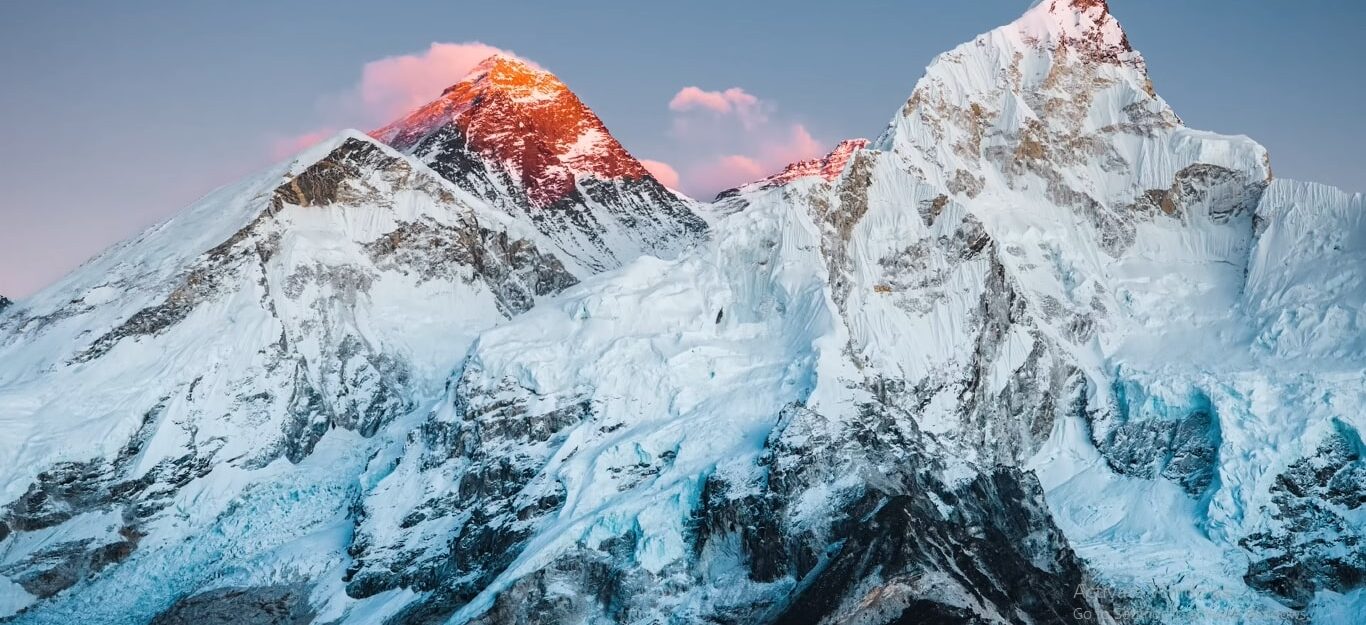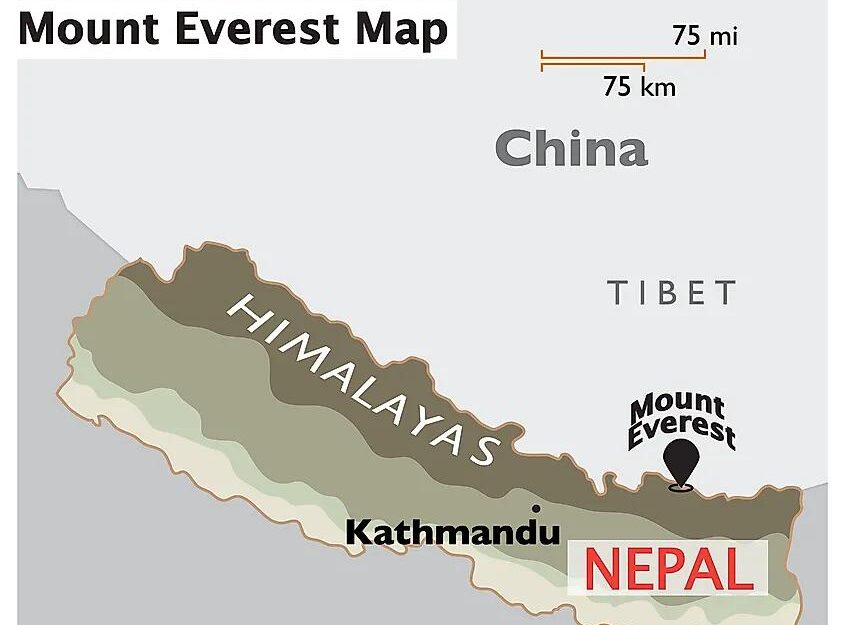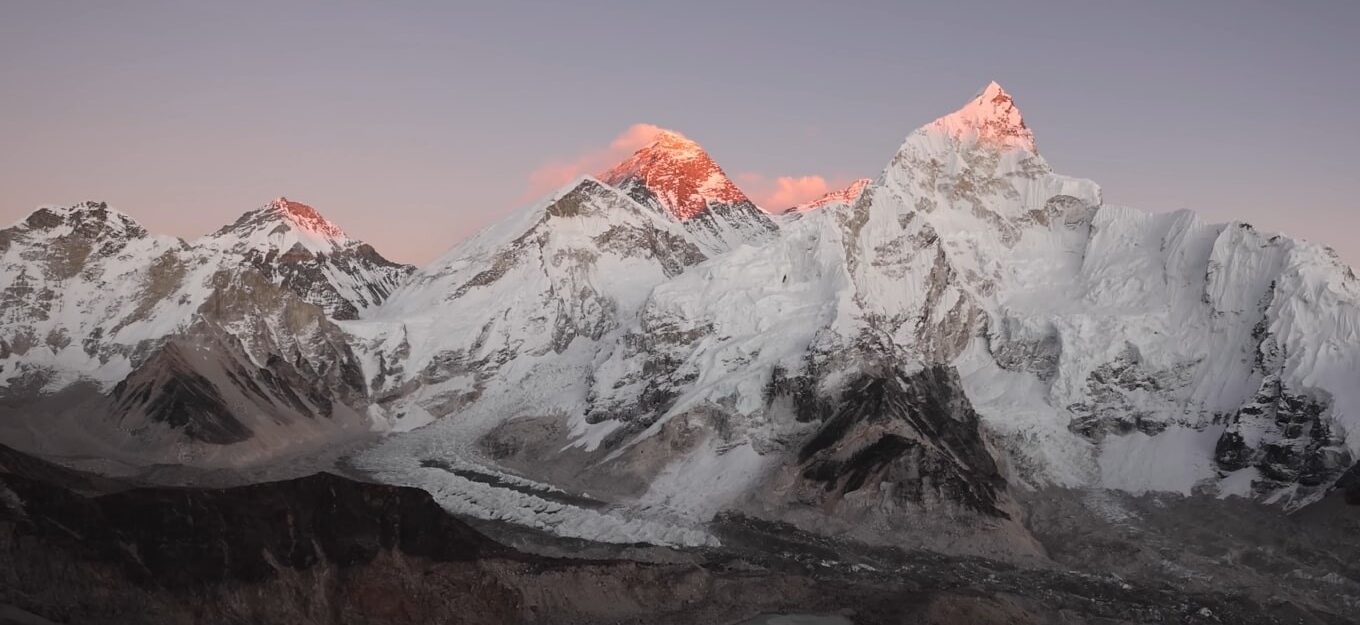
Location of Mount Everest -Nepal
Mount Everest, Called Sagarmatha in Nepali, and Chomolungma in Tibetan is the tallest mountain on Earth, standing at a breathtaking height of 29,029 feet (8,848 meters) above sea level. This majestic peak is in the Mahalangur Himal sub-range of the Himalayas, on the border between Nepal and Tibet (China).
Explanation of Mount Everest and its significance:
Mount Everest is one of the most iconic and challenging mountains to climb. In addition, it has a towering height and unpredictable weather conditions. Because of this, it has attracted adventurers, climbers, and mountaineers from all around the world.
Consequently, all of them seek to conquer its summit and experience its awe-inspiring beauty.
But Mount Everest is not only important for its mountaineering reputation; it also plays a significant role in the cultural and spiritual traditions of the Sherpa people who live in the region. For them, the mountain is a sacred place and a source of spiritual inspiration.
A brief history of the mountain and its exploration:
The history of Mount Everest is intertwined with the history of exploration and mountaineering. The first recorded sighting of the mountain was by British surveyors in the mid-19th century. But it was not until the early 20th century that expeditions were organized to try to climb the mountain.
The first successful ascent of Mt. Everest was in 1953, by Sir Edmund Hillary of New Zealand and Tenzing Norgay Sherpa from Nepal. Since then, many other climbers have reached the summit, and some have lost their lives in the attempt.
In this comprehensive guide, we will delve into the history, geography, and significance of Mount Everest. We will explore the fascinating story of how it was first discovered and climbed, as well as its role in local culture and global mountaineering. So, get ready to embark on an exciting journey through the world’s highest peak.
Geographical Location:

Mount Everest lies in the majestic Himalayan mountain range. It is the highest mountain range in the world. The Himalayas span several countries in South Asia, including Nepal, Bhutan, India, Pakistan, and Tibet (China).
The exact location of Mount Everest is on the border between Nepal and Tibet (China). The coordinates of the summit are 27°59′17″N 86°55′31″E.
The mountain is bordered by other soaring peaks, such as Lhotse and Nuptse. Similarly, it is a member of the Mahalangur Himal sub-range of the Himalayas.
To the north of Mount Everest is Tibet, a region of China. To the south of the mountain is Nepal, a small landlocked country that is home to eight of the ten tallest peaks in the world. The region surrounding Mount Everest is popular as the Everest region. It is characterized by stunning landscapes, including glaciers, valleys, and high-altitude lakes.
In this section, we will explore the geographical location of Mt. Everest and the surrounding region. Similarly, providing insights into the breathtaking natural beauty and unique cultural heritage of the area.
Physical Features:
Mount Everest is a towering peak that stands at an incredible height of 29,029 feet (8,848 meters) above sea level. It is the highest point on Earth and attracts thousands of climbers every year who seek to summit this iconic peak.
The height of Mt. Everest was first measured in 1856 by British surveyors. They used trigonometric techniques to calculate its altitude.
However, it wasn’t until 1955 that the exact height of the mountain was determined by Indian surveyors using modern technology. Since then, various measurements have been made, and the currently accepted height is 29,029 feet (8,848 meters).
Mount Everest has several peaks and ridges. Firstly, there is the main summit, which is the highest point. In addition, there is the South Summit, which is slightly lower.
The ridges of Mount Everest include the Southeast Ridge, the Northeast Ridge, and the West Ridge. However, the Southeast Ridge is the most popular route taken by climbers. This is because it provides the easiest and safest ascent to the summit.
The glaciers surrounding Mount Everest are also an essential feature of the mountain. The largest glacier is the Khumbu Glacier. It is located on the southern slope of the mountain and is over 17 miles (28 kilometers) long.
Other glaciers in the region include the Lhotse Glacier, the Nuptse Glacier, and the Changri Glacier. These glaciers are an integral part of the ecosystem of the region. They provide water and nourishment to the surrounding flora and fauna.
In this section, we have explored the physical features of Mount Everest. Its height, the various peaks and ridges, and the glaciers that surround it. Understanding the physical features of the mountain is crucial for anyone seeking to climb or explore this majestic peak.
Climate and Weather:
Mount Everest is in a region that is famous for its harsh and unpredictable climate, with climate zones that vary depending on the elevation and location.
Climate Zones:
The mountain ranges surrounding Mount Everest encompass a range of climate zones. Specifically, the lower regions of the mountain have a subtropical climate, with hot summers and mild winters.
However, as the elevation increases, the climate becomes cooler and more alpine, with cold temperatures and snowfall in the winter months. At even higher elevations, the climate becomes arctic, with freezing temperatures and high winds year-round.
Best Time to Visit:

The best time to visit Mount Everest is during the spring and autumn months. They fall between March and May and between September and November. During these months, the weather is relatively stable, with clear skies and dry weather. This makes it ideal for climbing and trekking.
Challenges Posed by the Weather:
Even during the best months, the weather on Mount Everest can be extremely challenging and unpredictable. High winds, low temperatures, and snowstorms can occur at any time, posing significant risks to climbers and trekkers.
It is essential to have a good understanding of the weather patterns in the region and to be prepared for all eventualities.
Exploration and Mountaineering:
Mount Everest has been a source of fascination for explorers and mountaineers for centuries. Similarly, many attempts to summit the peak and explore the surrounding region. In this section, we will look at the history of exploration and mountaineering on Mt. Everest, the different routes taken by climbers, and the risks involved.
First Successful Ascent:
On May 29, 1953, Tenzing Norgay, a Sherpa from Nepal, and Sir Edmund Hillary, a mountaineer from New Zealand, accomplished the first successful climb of Mount Everest. The pair reached the summit via the South Col route. It has since become the most popular route taken by climbers.
Different Routes:
There are several different routes taken by climbers seeking to summit Mount Everest. Each has its own set of challenges and risks. The South Col route, which was the first route to be successfully climbed, is the most popular and least technically challenging. Other routes include the North Col route. It is accessed from Tibet.
Risks Involved:
Climbing Mount Everest is an incredibly challenging and dangerous feat, and there are many risks involved. The most significant risks include altitude sickness, extreme weather conditions, and the risk of falls and avalanches.
Climbers must be in excellent physical condition. They have to have a good understanding of the terrain and weather conditions. Additionally, they should be adequately ready with the necessary equipment and supplies.
In this section, we have looked at the history of exploration and mountaineering on Mount Everest, the different routes taken by climbers, and the risks involved in climbing the mountain. It is undoubtedly a challenging and dangerous undertaking, for many climbers. However, summiting Mount Everest is the ultimate achievement in the world of mountaineering.
Mount Everest in Popular Culture:

Mount Everest has captured the imagination of people around the world. It has been featured prominently in popular culture in various forms. In this section, we will explore the role of Mt. Everest in literature and film, its emergence as a tourist destination, and the impact of tourism on the mountain.
Literature and Film:
Mount Everest has been the subject of numerous books, documentaries, and films. Each of them offers a unique perspective on the mountain and its surrounding region. Some notable examples include Jon Krakauer’s “Into Thin Air.” This chronicles the disastrous 1996 Everest expedition, and the 2015 film “Everest,” which tells the story of the 1996 tragedy.
Tourism:
Mount Everest has emerged as a popular tourist destination, attracting thousands of visitors each year who come to trek to the base camp and take in the stunning views of the mountain. The tourism industry has had a significant impact on the local economy. Similarly, this is providing employment opportunities and generating revenue for the region.
Impact of Tourism:
Tourism has provided many benefits to the local community. Moreover, it has also had a significant impact on the environment and the mountain itself. The high volume of visitors has led to issues such as littering, pollution, and the erosion of the mountain’s fragile ecosystem.
In recent years, there have been efforts to promote sustainable tourism practices and limit the number of visitors to the mountain to protect the environment and preserve the mountain for future generations.
In this section, we have explored the role of Mount Everest in popular culture, its emergence as a tourist destination, and the impact of tourism on the mountain.
While it has undoubtedly brought many benefits, it is essential to balance the economic benefits of tourism with the need to protect the environment and preserve the natural beauty of the mountain.
Environmental Concerns:
Mount Everest is not only a natural wonder but also an ecological treasure. Additionally, it is home to a unique ecosystem that supports a wide range of flora and fauna. However, the increasing number of tourists and mountaineers has led to environmental concerns that threaten the mountain’s ecological balance.
In this section, we will examine the ecological impact of tourism on Mt. Everest, measures taken to reduce the environmental impact, and the future of Mount Everest and its preservation.
Ecological Impact of Tourism:
The rise in tourism and mountaineering on Mount Everest has led to a range of environmental problems. This includes the accumulation of litter, the erosion of the mountain’s fragile ecosystem, and the pollution of the surrounding water sources.
The impact is not limited to the mountain itself but also extends to the surrounding communities and their livelihoods.
Measures Taken to Reduce Environmental Impact:
Efforts are being made to mitigate the environmental impact of tourism on Mount Everest. For example, the Nepalese government has imposed new regulations to reduce the number of climbers and trekkers allowed on the mountain.
Similarly, there are now initiatives to clean up the mountain and promote sustainable tourism practices. Additionally, local organizations and communities are working to raise awareness about environmental issues and promote responsible tourism.
Future of Mount Everest and Its Preservation:
The preservation of Mt. Everest and its ecosystem is critical to ensure the mountain’s future survival. There is a need for a collaborative effort between the Nepalese government, mountaineering companies, and local communities.
This will help to promote sustainable tourism practices, preserve the environment, and protect the mountain’s unique ecosystem. It is essential to strike a balance between promoting tourism and preserving the natural beauty of the mountain for future generations to enjoy.
In this section, we have examined the ecological impact of tourism on Mt. Everest, measures taken to reduce the environmental impact, and the future of Mount Everest and its preservation. It is essential to protect the mountain’s fragile ecosystem and preserve it for future generations to come.
Frequently Asked Questions (FAQs):
How Tall is Mount Everest?
With a height of 29,029 feet (8,848 meters), Mount Everest is the tallest peak in the world.
Which nation does Mount Everest belong to?
On the boundary between Nepal and Tibet (China), Mount Everest may be found in the Himalayas.
Can Anyone Climb Mount Everest?
No, climbing Mount Everest is not something that just anyone can do. Climbers must be in excellent physical condition. They should have prior mountaineering experience. Similarly, they should also be able to withstand the harsh conditions of high altitude.
How Many People Have Successfully Climbed Mount Everest?
Since the first successful ascent of Mount Everest in 1953 by Sir Edmund Hillary and Tenzing Norgay, thousands of people have successfully reached the summit. As of 2021, the number of successful ascents is over 10,000.
What Season Is Best for Climbing Mt. Everest?
The best time to climb Mount Everest is during the spring season (April and May) or the fall season (September and October). The weather is more stable, and the winds are calmer.
What is the Highest Mountain in the World After Mount Everest?
After Mt. Everest, the next highest mountain in the world is K2, also known as Mount Godwin-Austen. It stands at 28,251 feet (8,611 meters) above sea level.
Why is Mount Everest So Difficult to Climb?
Mount Everest is challenging to climb because of its extreme altitude, unpredictable weather, and the physical and mental demands of the climb. Additionally, the mountain’s steep and rocky terrain, as well as the risk of avalanches and other hazards. This makes it a formidable challenge for even the most experienced mountaineers.
What is the Death Rate on Mt. Everest?
The death rate on Mt. Everest is approximately 1.3%. This means that for every 100 people who attempt to climb the mountain, around 1-2 will not return.
How Has Tourism Impacted Mount Everest?
Tourism has had both positive and negative impacts on Mount Everest. It has brought economic benefits to the local communities and supported the development of infrastructure. However, it has also led to environmental degradation and put a strain on the mountain’s delicate ecosystem.
In recent years, there has been a push towards sustainable and responsible tourism practices to mitigate the negative impacts.
Conclusion:
Mount Everest is a remarkable mountain that has captivated people’s imaginations for centuries. In this comprehensive guide, we have explored the geographical location, physical features, climate, exploration and mountaineering, popular culture, and environmental concerns, and answered frequently asked questions about Mt. Everest.
We learned that Mount Everest is the highest mountain in the world, standing at 29,029 feet (8,848 meters) above sea level. It is located in the Himalayas, on the border between Nepal and Tibet (China). Its physical features include various peaks and ridges, as well as glaciers surrounding the mountain.
We also discussed the climate and weather around Mt. Everest. The first successful ascent of the mountain, the risks involved in climbing, and the impact of tourism on the mountain’s delicate ecosystem.
Furthermore, we answered some of the most commonly asked questions about Mount Everest, such as the death rate on the mountain and the best time to climb.
In today’s world, Mount Everest holds great significance as a symbol of human endurance and achievement. It is a popular destination for adventurers and tourists alike.
Similarly, the economic benefits of tourism have helped to support local communities. However, it is also important to consider the environmental impact and the need for sustainable tourism practices. This is to ensure the preservation of this natural wonder for future generations.
Inquiry
If you want to know anything regarding the trip or any other issue, please feel free to ask us
